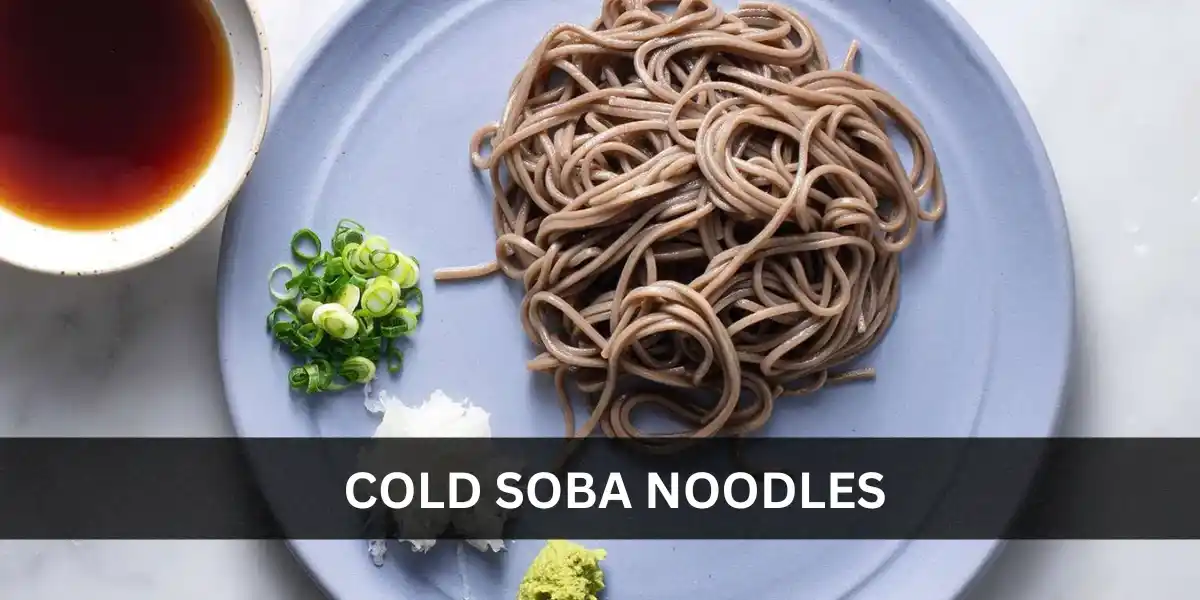An easy and speedy recipe for cold soba noodles that can be prepared in a short amount of time. In order to prepare this dinner, dry buckwheat noodles, which are commonly referred to as soba noodles, along with a few other pantry staples from Korea are utilized.
It is a wonderful dish to cook on a weeknight or a Sunday when you are not too busy so that you can take advantage of the fact that it is so simple to put together. When you eat it with noodles, it will quickly become your new favorite food to eat, especially during the warm months of summer.
COLD SOBA NOODLES WITH PERILLA OIL DRESSING: WHAT exactly are these?
Perilla oil noodles, which are also commonly known as cold soba noodles with perilla oil dressing, are currently experiencing a boom in popularity all over the world. They are one of the most well-liked Korean noodle meals that are currently experiencing a surge in popularity. The term “perilla-oil noodles” is another name for perilla-oil noodles that is often used. Perilla oil dressing is another term for perilla oil noodles. Perilla oil noodles do not go by this name. For the purpose of referring to this particular location, which is connected to the kingdom of Memil Guksu, the Korean language makes use of the phrase “Deulgireum Makguksu” (which can also be written as “들기름 막국수”).
Both buckwheat and noodles are referred to as memil in Korean. Guksu is the Korean name for noodles. The Korean language makes use of both of these words. Both of these words have their roots in the Korean language, which is where they are also used. Toasted sesame seeds, perilla oil, and soy sauce are the components that are utilized in the preparation of the sauce that is used to garnish soba noodles throughout the cooking process. In addition, other pantry essentials are utilized. After the boiling and draining operations have been finished, this sauce is next added to the noodles. This happens immediately after the boiling process. When the noodles have reached the desired level of doneness, the sauce is then delicately poured over them.

Compared to the other kinds of soba noodle dishes that are popular in Korea, this recipe for a sauce for noodles is not as spicy as those other dishes can be described as being. This is because the sauce is made with a combination of different ingredients. Due to the fact that the sauce for noodles is produced with a separate set of components, this is the case. To provide a more precise description, this particular dish is categorized as Ganjang Bibim Guksu, which is also commonly known as 谄장 비빘국수, which is a type of Korean cuisine that consists of a mixture of noodles flavored with soy sauce.
In the event that you are someone who takes pleasure in consuming hot noodles, you might want to think about switching to one of these two recipes instead. Both of them are options that both have a wonderful flavor. Besides soba noodles, there are also noodles that are topped with a sweet chili soy vinaigrette and hot kimchi noodles mixed. These noodles are a combination of the two types of noodles. When it comes to available possibilities, these noodles are one of them. A versatile option to take into consideration is they.
As can be seen in the picture that is provided below, it is also possible to get perilla oil noodles in pre-packaged form prior to making the purchase of these noodles. You are able to carry out this action, which is something that they are capable of accomplishing. On the other hand, I came to the realization that this was not even close to being as exquisite as the ones that I had prepared at home. Not even near.

IN WHAT WAYS IS PERILLA OIL DEFINED?
Perilla oil is a type of vegetable oil that is created by first heating the seeds of a plant that is associated with the perilla plant and then extracting the oil from the seeds. The flavor and aroma of toasted perilla oil are similar to those of toasted sesame oil; it is a light brown hue and has a slight nutty and earthy aroma. Perilla oil is a product of the perilla tree. On the other hand, the flavor profile is really different from that in a significant way. It plays a significant role in the preparation of Korean dishes that involve the sautéing of vegetables.
If you are interested in learning more about perilla oil, you might find this post, which is titled “Perilla Oil,” to be helpful to satisfy your curiosity.
SUBSTITUTION SUGGESTIONS AND RATES
It is recommended that you use either soba noodles or buckwheat noodles for this recipe. Both of these varieties of noodles are available. It is possible to swap either of these types of noodles with somen noodles (somyeon 솜면) in the event that you are unable to locate either of these types of noodles. However, despite the fact that they are significantly thinner than soba noodles, they are good at absorbing tastes. It is probable that the chewing sensation is not exactly accurate due to the fact that they are thinner.
You still have the option of utilizing sesame oil in the case that you are unable to acquire perilla oil. Both of these oils are available. While the flavor profile of sesame oil is rather distinct, the nutty aroma and flavor of sesame oil are more identical to those of perilla oil than they are to those of other goods. This is because perilla oil has a more distinct flavor profile. When you are using sesame oil, it is essential to utilize toasted sesame oil rather than untoasted sesame oil. This is because the latter will result in a flavor that is more suggestive of nuts than the former. In addition to this, make sure to use a smaller quantity of it than what is called for in the recipe. In the event that the recipe calls for two tablespoons of perilla oil, for example, you should substitute one to one and a half tablespoons of sesame oil for the other two tablespoons.
Tsuyu is a Japanese condiment that can be used for a variety of reasons, such as as a dipping sauce or as a foundation for Japanese the soup that is made with noodles. It can be used in a variety of cuisines. It is most commonly used as an accompaniment to dishes that feature soba and udon noodles, in addition to items that do not contain tempura. This is the most common scenario.

As an additional point of interest, this sauce is utilized in a few dishes that are either Korean or Korean-Japanese fusion in nature. In place of tsuyu, you could substitute homemade dried anchovy and kelp stock, which is sometimes referred to as Korean soup stock. This substitution is entirely up to you. On the other hand, due to the fact that tsuyu has a flavor that is considerably more intense than that of Korean soup stock, you will need to dilute it with some water in order to obtain a flavor that is more balanced.
THE APPROACH TO SERVING
It is extremely recommended that the noodles be served cold because this meal is primarily a cold noodle dish. This is because the noodles are included in the meal. In addition, because these soba noodles are already prepared, you won’t have to serve any additional meals as a side dish when you utilize them because they are already prepared. In the event that, on the other hand, you would like to improve the dinner, you can do so by preparing additional toppings (which are comparable to those that are outlined in the recipe that is supplied below). I don’t bother with any other ingredients because the goal of this soba noodle is to be as simple as possible. As a general rule, I don’t bother with any additional ingredients.
If you want to experience more of the flavor and texture that is characteristic of Korean cuisine, you can serve it with pickled radish or cucumber pickles. This is a possibility.
Additionally, it is conceivable to serve it with white kimchi; however, I would not advocate using ordinary kimchi because it has the potential to overshadow the flavor of the meal. There is also the possibility that white kimchi might be used.
THIS KOREAN SUMMER NOODLE IS AVAILABLE IN ADDITION TO These Recipes
When it comes to noodles, I simply cannot get enough of them, particularly during the warmer months of the year. Due to the fact that these noodles are so delicious and difficult to resist, it is vital that you give them a try. You will not be let down in any way, shape, or form under any circumstances.
INGREDIENTS FOR COLD SOBA NOODLES, SERVES 2
Table of Contents
In the event that you do not possess tsuyu, you can replace it with three tablespoons of handmade dried anchovy and kelp stock (also known as Korean soup stock), and you can delete the water from the components for the soba sauce.
** If you are interested in learning more about the basic components used in Korean cuisine, check out my list of Korean ingredients.
HOW TO MAKE COLD SOBA NOODLES
1. Boil the soba noodles in rolling boiling water just until tender following the package instructions. Drain and rinse in cold water to cool down. Transfer the noodles into a mixing bowl.
2. While the noodles are cooking, combine the sauce ingredients in a small bowl and mix them well. Set aside.
3. Combine the noodles with the sauce in a mixing bowl.
4. Transfer the noodles into a bowl. Garnish with the seaweed, green onions, and sesame seeds by sprinkling them around the bowl. Top up with your choice of other optional topping ingredients listed above. Serve.

